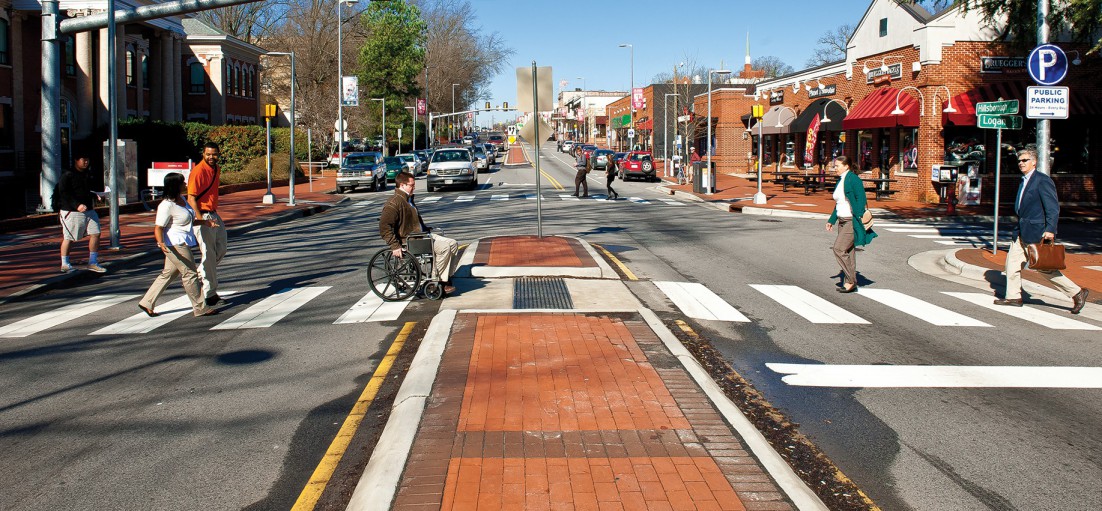Benefits
Bicycling and walking facilities provide a wide range of benefits to individuals, their communities, and the surrounding environment. The information below summarizes some of the many types of safety benefits that can be gained by accommodating pedestrians and bicyclists and slowing traffic within North Carolina's transportation network.
Investments in walking and bicycling facilities have a direct, positive impact on safety.
Design Treatments, Traffic Calming, & Reduced Collision Risk
Safety benefits are some of the most important benefits of walking and bicycling improvements. Studies show that installing pedestrian and bicycle facilities directly improves safety by reducing the risk of pedestrian-automobile and bicycle-automobile crashes. Increased enforcement has also been shown to reduce crash risk for pedestrians and bicyclists. The following is a table of common pedestrian and bicycle design treatments and interventions and their resulting collision rate reductions:
| Design Treatment | Crash Reduction Rate |
|---|---|
| Provide minimum 4' paved shoulder to avoid walking along roadway | 71% (pedestrian crashes) |
| Increase enforcement to reduce speed | 70% (pedestrian crashes) |
| Install sidewalk to avoid walking along roadway | 65-89% (pedestrian crashes) |
| Install pedestrian refuge islands | 56% (pedestrian crashes) |
| Install raised median + crosswalk | 46% (pedestrian crashes) |
| Improve lighting at intersections | 42% (pedestrian injury crashes) |
| Provide bike lanes | 36% (bicycle crashes) |
| Provide a bicycle box (advance stop bar to leave space for cyclists) | 35% (bicycle crashes) |
| Add exclusive pedestrian phasing to signalized intersection | 34% (pedestrian crashes) |
| Restrict parking near intersections | 30% (pedestrian crashes) |
| Convert unsignalized intersection to roundabout | 27% (pedestrian crashes) |
| Improve/install pedestrian crossing | 25% (pedestrian crashes) |
| Install pedestrian countdown signal heads | 25% (pedestrian fatal/injury crashes) |
| Increase enforcement related to motorist yielding in marked cross-walks + education campaign | 23% (pedestrian crashes) |
| Install pedestrian overpass/underpass at unsignalized intersection | 13% (pedestrian crashes) |
Infrastructure for walking and bicycling can also help to reduce collisions and resulting injuries and fatalities by contributing to traffic calming measures. Installing bicycle lanes, sidewalks, or other improvements can help to reduce vehicle travel lane width and make pedestrians and bicyclists more visible to drivers. These changes to accommodate pedestrians and bicyclists are often effective at slowing traffic to a people-friendly speed and can help to ensure speed limit compliance by matching the physical design of the road to the posted speed limit. Slowing traffic by even 10 miles per hour can greatly reduce the risk of a pedestrian fatality in the event of a collision:
| Vehicle-Pedestrian Collision Speed | Pedestrian Fatality Rate |
|---|---|
| 40 mph | 85% |
| 30 mph | 45% |
| 20 mph | 5% |
Including designated facilities for pedestrians and bicyclists provides safety benefits to all users. Streets with bike lanes have been shown to be safer not just for bicyclists, but for pedestrians and drivers as well. Streets without bicycle facilities pose a greater collision risk: The most bike crashes happen on major streets without bicycle facilities, followed by minor streets without facilities, bike paths, and then bike lanes. Furthermore, installing bike lanes increases cyclist predictability, reduces wrong-way riding and sidewalk riding, and increases traffic control compliance.
Safety in Numbers
Not only can pedestrian and bicycle facilities reduce injuries and save lives, but they can also help a greater number of people feel comfortable taking a walk or riding a bike in their community. As walking and bicycling rates increase, streets become safer for pedestrians and bicyclists. This is known as the "safety in numbers" principle: When walking and bicycling rates double, per-kilometer pedestrian-motorist collision risk decreases by 34%. Moreover, cities with high bicycling rates tend to have lower crash rates for all road users. In Minneapolis, bicycle commuting increased by 100% between 2003 and 2007, and bicycle crashes have declined an average of 20% every year since 2000. Bicycling rates in New York City increased 289% between 2001 and 2011, and over the same period safety increased for all road users. Traffic fatality rates decreased to their lowest recorded levels in a century while bicycle injury and fatality rates remained unchanged despite a near-quadrupling in the number of riders.
Improved environments for walking and bicycling therefore contribute to the safety of the transportation system in two important ways: by directly reducing collision risk and by making walking and bicycling more visible and more common modes of travel. Safe places to walk and bike are especially important for non-driving populations who require a safe, reliable, and convenient transportation alternative. Non-drivers include children and teens, the elderly, low-income populations, and people with disabilities, among others. These non-driving groups, which together make up about one-third of the U.S. population, are the most at risk when walking and bicycling accommodations are lacking. Integrating pedestrian and bicycle treatments as a basic element in the transportation network helps to make streets safer for everyone.





